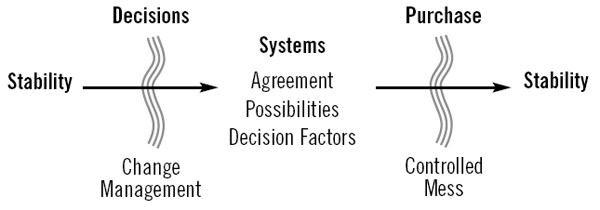What’s stopping you from closing all of the sales you should be closing?
How do you know that your buyers are ready, willing, and able to buy now?
Being a professional seller with a great, fairly priced product, doesn’t cause clients to buy, or you would have closed all of the prospects you’ve tried to sell.
Below, you’ll find some of the main ideas behind Buying Facilitation®. For a more complete understanding of the process, you may want to purchase Sharon-Drew’s newest book, Dirty Little Secrets.
» Purchase Dirty Little Secrets at Amazon.com «
How Buyers Buy

A closed sale is comprised of two equally important sets of decisions: the buying decision, and the product or solution-placement decision. Until now, sales has only addressed the needs-assessment and product- or solution-placement end. But until a buyer recognizes all of the unique internal decisions – both obvious and concealed, and certainly concealed from an outsider – that must be made for buy-in to occur, no sale will happen.
Unfortunately, buyers don’t complete their process of managing their stakeholder’s unique decision criteria until they have already begun searching for a solution. The length of time it takes buyers to manage this decision process is the length of the sales cycle.
It’s now possible to have the buyer start the process of recognizing and managing their stakeholder’s buy-in requirements before spending time and effort assessing needs or introducing product. Buying Facilitation®, used at the front end of the sales cycle, will thereby shorten your sales cycle, help buyers manage hidden or difficult internal issues that have created the problems they now face, and put you on their decision team as a result of the high level help you’ve offered.
» Buy the Buying Facilitation® eBook! «
An example…
A global bank agreed to a multi million dollar software solution from my client, a well-branded consulting company. The implementation hadn’t move forward for two years, costing the bank one billion dollars in lost revenue. My client had been doing small projects peripheral to the large implementation and met regularly with many of the “C” level execs. They knew the project scope, outcomes, necessary technology, user requirements, and were buddies with the management, user groups, etc. But nothing was happening.
I was hired to call the bank’s CEO. It became apparent, within 15 minutes, that the bank had a 4 year history of problematic relationships with one of the union reps left over from the previous CEO and until that was resolved, nothing would happen. My client had only needed to ask two Facilitative Questions – before submitting a bid, before understanding the specific needs – to have uncovered the problem:
What has stopped you from managing this problem years ago?
And what would need to happen now for you to be able to factor in a solution and move forward?
The decision team met with the union reps two weeks later, and my client started the project within two months. The take aways here?
- The buyer (all “C” execs) didn’t do a 360 assessment and took the lead of the CEO around the delays, which all seemed reasonable (initiatives, budgets, etc).
- Although the seller understood the client’s Identified Problem, and had the relationships, solution, and agreement, they couldn’t move forward until an historic, hidden issue was managed.
- There was no way for the sales model to get to this hidden problem, as it lay well outside the purview of the Identified Problem. The questioning sequence in Buying Facilitation® would have unearthed this issue on the first call, saving both groups money and time.
» Learn the whole Buying Facilitation® system on your own! «
Solving problems with Facilitative Questions
Problem #1
Buyers must manage the obligatory internal political, policy, and people decisions. With conventional or consultative sales, sellers remain outside of the unique decision making processes which buyers must manage to get buy-in for a purchase.
Traditional Sales Model: a needs-assessment, problem-solving, product placement model, biased toward matching perceived needs to product capability.
Buying Facilitation®: a decision facilitation tool used with sales to guide the buyer through all of the internal elements that must be addressed for consensus to occur among stakeholders.
Facilitative Question: How would you and your decision team know when it was time to add a new vendor to the one you’re currently using?
Problem #2
Buyers have a much larger problem than solving the tip of the iceberg that shows up as the Identified Problem: they must get agreement from the elements that have created this problem through time. Until they do, they will delay the sales cycle.
Traditional Sales Model: based on buyers choosing their best solution to solve their Identified Problem.
Buying Facilitation®: based on systems thinking and the structure of how decisions get made; manages the fear of disruption and change.
Facilitative Question: What has stopped you from fixing that until now?
Problem #3
Sellers are outsiders and have not been able to enter the buyer’s unique system to effect change, relegated merely to helping manage the problem resolution from the product/solution/service end.
Traditional Sales Model: manages problem-solving, needs assessment, and solution choice.
Buying Facilitation®: facilitates buyers in recognizing, managing, and reconfiguring the historic internal decisions so change can happen.
Facilitative Question: What would you and your decision team need to consider to ensure that the stakeholders and policies that created the Identified Problem would be willing to get on board with new choices you might make?




